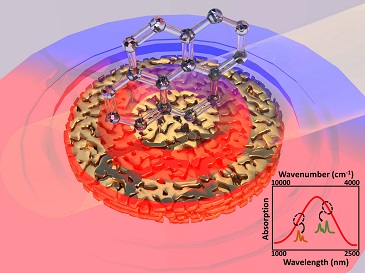
Researchers from the University of Houston have reported a new technique to determine the chemical composition of materials using near-infrared light.
The work could have a number of potential applications, including improving downhole drilling analysis in the oil and gas industry and broadening the spectrum of solar light that can be harvested and converted to electricity, said Wei-Chuan Shih, associate professor of electrical and computer engineering at UH and lead author of a paper describing the discovery published June 22 in Nano Letters.
“From a scientific point of view, it’s quite a novel discovery to excite plasmonic resonance at near-infrared and make it work for us,” he said.
That means substances which can’t be accurately measured by sensors operating on the infrared spectrum can now be studied in far more detail than that provided by current techniques using the near-infrared spectrum.
In addition to Shih, the other authors include post-doctoral researchers Greggy M. Santos and Oussama Zenasni and graduate students Fusheng Zhao and Md Masud Parvez Arnob.
Spectroscopy using the infrared spectrum – an analytical technique using infrared light to scan and identify the chemical composition of organic, polymeric and some inorganic materials – is an important tool, but it has limitations. Infrared light is absorbed by water, so the technique doesn’t work with water-based samples.
Near-infrared light scanning is compatible with water, but current techniques are less sensitive than those using other wavelengths.
“To overcome these barriers, we have developed a novel technique to simultaneously obtain chemical and refractive index sensing in 1-2.5 µm NIR (near infrared) wavelength range on nanoporous gold (NPG) disks, which feature high-density plasmonic hot-spots of localized electric field enhancement,” the researchers wrote. “For the first time, surface-enhanced near-infrared absorption (SENIRA) spectroscopy has been demonstrated for high sensitivity chemical detection.”
Shih said working with near infrared light is usually “a double-edged sword,” as it can be used with water-based samples but doesn’t provide the needed detail. “We showed water is not an issue, but we can also increase the sensitivity of what we want to measure by 10,000 times,” he said.
He and members of his lab have worked with nanoporous gold disks since discovering the structure in 2013. For this project, he said they “tuned,” or designed, the nanodisks to react when exposed to specific wavelengths, making it possible to develop a sensing technique with the advantages of both infrared and near infrared scanning.
The technique was tested with various crude oil and other hydrocarbon samples, and Shih said it could be helpful in downhole fluid analysis, which uses near infrared spectroscopy to analyze material found deep in a well. The technique allows drillers to know quickly what’s below the ground or seabed, but he said the new technique could simplify the process because it requires a smaller sample for analysis, an obvious advantage in laboratory characterization.
Oliver C. Mullins, a scientific advisor at Schlumberger and the primary originator of downhole fluid analysis, said the discovery holds potential for both the lab and the field.
“Optical spectroscopy has made significant contributions in the oil and gas industry beyond laboratory characterization,” he said. “In particular, in situ fluid analysis in oil wells based on vibrational overtones and electronic absorption in the visible and near-infrared wavelengths has become an industry standard in wireline well logging. SENIRA brings in an exciting prospect for potential better sensor technology in both field and laboratory settings.”
Shih said researchers are thinking about new ways to do things using the technique. “We can do a lot of oil typing with tiny amounts of oil.”
Although the paper uses hydrocarbon composition analysis as an example of how the technique could be deployed, Shih said it can be applied to any molecular species. That broad potential use, in addition to the novelty of the technique, is why Nano Letters published the paper, he said.
The paper can be found: http://pubs.acs.org/doi/abs/10.1021/acs.nanolett.6b01959